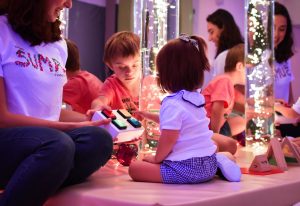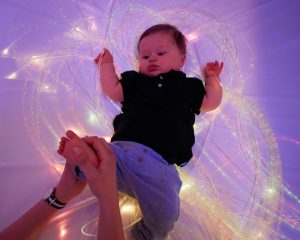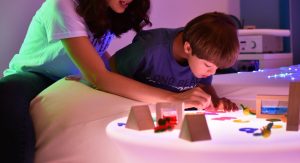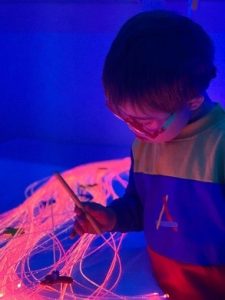Jennifer Arellano
Social Media & Content Manager at Qinera
Read more postsAt Cromo Suma Foundation (Spain) we approach sensory stimulation therapy in a comprehensive manner. We work with the exteroceptive senses, such as taste, hearing, touch, smell and sight; and with the proprioceptive senses, such as vestibular, touch and proprioception itself. The therapeutic intervention consists of stimulating the senses through motivating and meaningful activities,directed by the therapist, to achieve the child’s active participation.
It is imperative to have an objective in mind when working therapeutically.
The first thing to keep in mind is that each child, whether with Down Syndrome, or with any learning and/or developmental difficulty, has his or her specific challenges as well as preferences. Thanks to the tools offered by our Multisensory Room, we can implement various therapeutic processes based on the ability to feel, inherent to human beings, regardless of their abilities or difficulties. In this way, we achieve the objectives proposed in each therapeutic session, always personalized and adapted to each child.

It is important to note that all the interventions carried out, both in the multisensory room and outside it, have:
With these three prerequisites, we can provide speech therapy and academic reinforcement sessions, for example, with which the child engages in a sensory game we offer, while keeping their attention and participation throughout and, in turn, this allows us to clearly observe their communicative intent. Our sensory room also gives us the possibility to work repetitively on the same concept, thus maintaining the child’s sustained attention, while also engaging in a much more attractive activity.
On the other hand, we also use the tools offered by the multisensory room and its infinite possibilities of intervention for physiotherapy and psycho-neuromotor therapy sessions. During this time we can add a third person in the session (the mother or father, for example) and work on the bond between parents and child, as well as the separation between both people, thereby promoting autonomy and emotional regulation.

All our sessions have a start and finish ritual in order to help the child to prepare for the upcoming activities. This helps improve the communication and the development of one’s identity. We use different sensory, visual, olfactory, tactile, auditory, gustatory, proprioceptive and vestibular tools to create the most favorable work environment for the child, where he or she is the one who directs the exploration of the environment. By creating this enriched environment with concrete (and strategically planned) stimuli, we improve learning which in turn helps brain plasticity while also developing the so-called “sensory awakening”.

Sensory stimulation is both therapeutic and educational. Sometimes, we conduct sessions in the multisensory room while combining different objectives:
 There are endless tools at our disposal to achieve the goals we set for ourselves in a sensory room. The sessions are very meaningful for the user and bring us important results we seek: a sensory awakening.
There are endless tools at our disposal to achieve the goals we set for ourselves in a sensory room. The sessions are very meaningful for the user and bring us important results we seek: a sensory awakening.
These spaces also allow us to work on specific objectives in different ways, and facilitate interaction and participation amongst those involved. Thanks to our room, we create magical and unique environments that make our children live an active, rich and emotional experience as they develop.
![]()
 This article was written by María Roa, speech therapist; and Laia Macías, sociologist, at Cromo Suma. If you want to know more about the Cromo Suma team and their project, we invite you to visit their official website.
This article was written by María Roa, speech therapist; and Laia Macías, sociologist, at Cromo Suma. If you want to know more about the Cromo Suma team and their project, we invite you to visit their official website.
If you want to learn more about the benefits of Multisensory Environments or see how you could adapt it to your space, therapeutic goals, and users, you can send an email to hello@qinera.com.